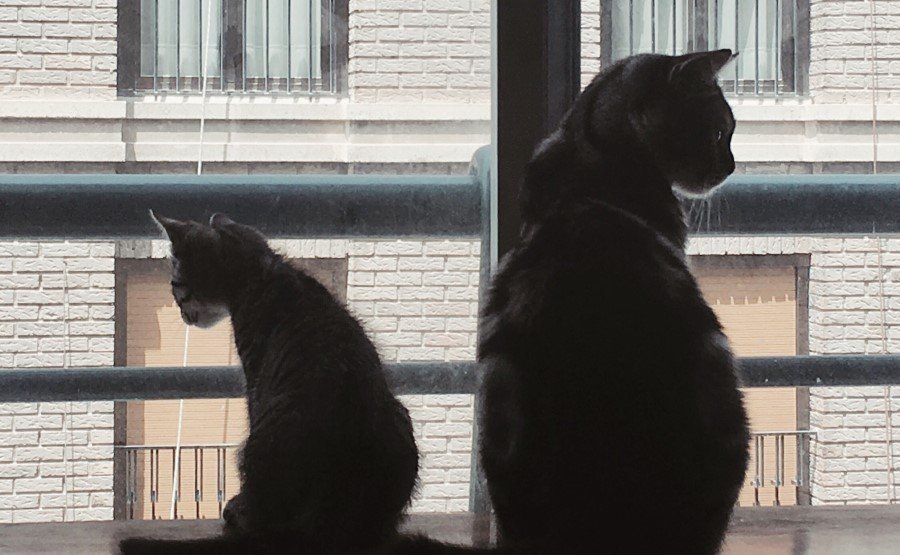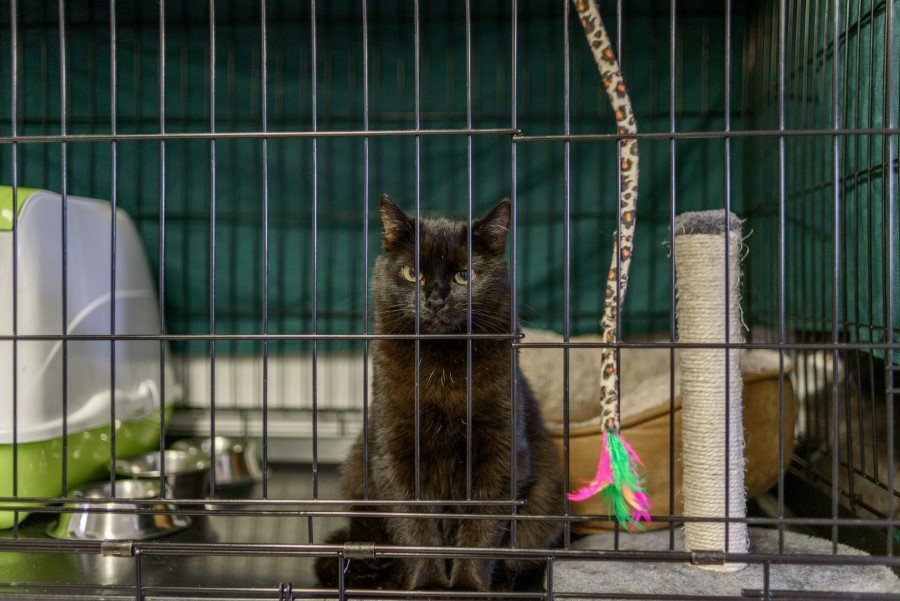For many individuals going to a rescue or a shelter cat is the only way they will acquire a cat or kitten while others would not consider this. The truth is, answering the question “should I get a rescue cat” is a personal choice and there are pros and cons on both sides of the fence.
The average cat can have several litters per year if unspayed and by the time they are four years old can have given birth to up to tens of thousands of kittens. Spaying and neutering cats are imperative but many stray cats abound as they are abandoned more than dogs or puppies.
Table of Contents
The Pros of Cat Adoption from a Rescue or Cat Shelter
This is a very satisfying method for many of obtaining a cat and some owners take in many older or unwanted cats. Let’s face it, as all cat lovers know, “cats can be like potato chips”. There is never enough! So now for the discussion on the pros. Too many times an otherwise loving cat owner becomes ill or dies and a cat becomes homeless and ends up in a shelter/rescue. We will explore both pros and cons here but chose pros first as all cats are great cats if given a chance.
-
Saving a cat who really needs love
There is a myth that cats because they are Alpha predators can do well in the wild and some end up homeless because they are left behind during a move or death or illness as we spoke of previously. This is not true. Many starve or die early of disease. The average lifespan of a cat in the wild is only five years as compared to the fifteen to the twenty-year range for a domesticated cat. Vet care, as well as good food, toys, and shelter, are just as needed by feral cats.
-
Preventing cat suffering
As mentioned above, overbreeding by cats living on their own is a real problem. . The more they breed the more the population explodes. It is a vicious cycle and many cats in the wild are abused when left to fend on their own. Older cats especially if they end up as wild cats do really badly and will gladly come to anyone that shows love. Any geriatric cat has less of a chance of adoption too as most individuals love kittens.
-
Satisfaction in knowing you are doing the right thing
There is a myth that cats that have lived outside or are older cannot be domesticated or can’t adapt eventually to new surroundings, whereas they generally do well when treated with love and kindness. While it may take some time for some to adapt they do eventually.
The younger the cat or kitten the sooner this becomes a reality but even an older feral cat does start adapting in time. It is a very welcome sight to see a feral prosper from a half-starved and anxious cat to one who cannot live without you.
-
Adopted cats can be the most loyal
They become very attached to their owners and can even experience anxiety when left in a separate room. Most cats do follow their owners but adopted cats are like “glue” and can and will sit by the tub for hours while you take a bath and patiently wait inside a doorway when you do go out. The joy when you finally are in their sight again is immensely gratifying.
-
Abandoned or adopted cats are not often finicky about food
Shelters and rescues feed the same type of food for all depending upon age. That doesn’t mean you should feed them scraps, it just means that they do not turn their noses up at any kind of food served up.
While older cats might need an adjustment period, the shelter/rescue food should be used until a cat becomes comfortable.
Feeding good food will enhance well-being and recovery from traumas sooner. Simple is best and trying a variety of wet and dry a little at a time is the best methodology. Some cats like raw food and the closer the food is to natural the more they will like it. Visit any shelter or rescue and they devour the dry food given no matter what type so always be sure to ask for some of that to take with you.
The Cons of Cat Adoption from a Rescue or Cat Shelter

While there are plenty of “pros” those seeking a kitten or cat cannot ignore the “cons” and only you can decide if you have the patience for some of these cons.
-
A shelter cat removed from the shelter can be anxious
This is just the truth. While happy to be out of the shelter cats, in general, do not enjoy being relocated. They are territorial and like to stay where they are. An adopted cat or kitten will need private space and be allowed to hide if they need to for as long as they need to.
Petting might be foreign to them as they might not like to be petted much or perhaps you are petting in the wrong spot! Some cats generally never enjoy being picked up or transported. Most do learn to cuddle but might not ever sleep with you, and some are very Alpha which can be upsetting to family members and other animals.
Learning to fight is a survival instinct that a cat develops even if only outside without supervision for only a short time. Cats do have memory and might carry this trait for life. Trauma can exist and you will have no way of knowing the cat’s background.
-
Adopted cats might not like other pets or children
Having a visitation or “meet and greet’ can be beneficial. Many shelter/rescue cats are also coming out of cat fostering and can be bonded with the foster cat’s parents. Sometimes with older cats, many visits might be needed before final adoption occurs.
This is how normal adoption of children occurs and the same process is observed by any good rescue or shelter. The adoptive process does not always work out and sometimes another cat or kitten must be chosen. Abandoned or relocated cats are already fairly frightened and might be abused so acceptance by them and you must occur with each other.
You do not know their backgrounds and they know nothing about you and cannot talk so it can be touch and go.
-
“Shelterers” as they are called can have emotional or physical problems
Some bad behaviors might be apparent such as biting, scratching, aggression, and even PTSD (Post Traumatic Stress Disorder). These problems are generally overcome given time but it takes patience on the part of any person who adopts one.
Strange sights and sounds may startle a new cat in a household and they might turn into “escape” artists who do want to crave the outdoors just to escape the anxiety they feel or out of curiosity. Planning outdoor time will assist when dealing with a feral who misses the outdoors. Vets many times employ cat behaviorists who can retrain YOU in how to deal with behavior problems. Cats own you, you don’t own them.
-
Vet trips can be counted on many times
Most shelters and rescues will ensure that a cat or kitten has a checkup and flea, tick, and deworming treatments before leaving a shelter or rescue. However, the new owners generally must sign a paper that spaying or neutering will take place within 30 days of adoption if a cat or kitten is not “fixed”. This is a cost that should be done for every cat but most shelters and rescues will hold owners to this within a timeframe or else reclaim the cat or kitten.
Follow-up vet care is also necessary within a certain time frame. Even in an adult cat litter box training might also be needed or a cat in an unknown territory will go anywhere and cover it up. Even small maintenance like bathing, grooming, and nail clipping might need to be done by a vet as skittishness over any routine maintenance generally is present.
-
Continuing problems with ear mites
These can continue indefinitely because of dirt buildup in a feral’s ears. Although common in dogs and all cats, felines who are on their own have the most problems. These microscopic mites linger for what seems forever in felines.
A sign of mites is continual scratching behind the ears or even shaking of the head. Ear mites proliferate like mini-cockroaches so can come back time and time again. You will not be able to see them with the naked eye as they are microscopic, but if a cat is not exposed to the outdoors and the ear canal looks dirty, then the cat or kitten has mites.
-
You must become a cat body language specialist
Having a new cat requires a Ph.D. practically in body language. Cats communicate through meowing and body language and some cats do more so through body language than vocalization as they have learned to be silent. Not all cats purr and many unsocialized cats do not nor do they meow. Cats learn from other cats and some cats live their lives in solitude before adoption so do not have the early socialization or exposure that comes from being part of a cat family outdoors.
Rescuing a Cat – Our Verdict
There are good and bad rescues/shelters. Some unscrupulous breeders can pretend to be shelterers and are not regulated and ask for donations for the cat but are selling them as food for pet snakes, especially kittens.
Other shelters that are not regulated can use the donations for their own purposes. Check the cat thoroughly and the conditions of the shelter/rescue and ask questions and do research!
At the end of the day, the question of “should I get a rescue cat” can be answered by thinking about these few things:
If you have love to give, a warm place to stay and you can afford to provide the food and veterinary care that a rescue cat needs, we say – go for it!

Jonathon Hyjek is an entrepreneur and cat-lover. He is married to Joy and they share their home with their 2 feline-friends, Franklin & Ollie. Jonathon is a self-admitted “Crazy Cat Guy”. He started this website because of his love for his own cats and their well-being.

